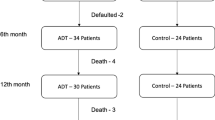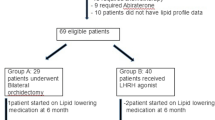Abstract
Background
To explore arterial stiffness during the administration of androgen deprivation therapy (ADT) in patients with prostate cancer (PCa), a new indicator, the cardio-ankle vascular index (CAVI), and serum lipid profile changes were monitored.
Methods
A prospective study assessed the changes in arterial stiffness using the CAVI and clinical laboratory variables among 58 men with prostate cancer treated with ADT for 6 months. Furthermore, patients who had a high risk of developing arterial stiffness after ADT were investigated.
Results
The whole cohort had no significant increase in arterial stiffness within 6 months after ADT, but 55.2 % of patients had an increased CAVI. Serum levels of total cholesterol, high-density-lipoprotein cholesterol (HDL-C), and low-density-lipoprotein cholesterol (LDL-C) increased significantly at 1 month after the start of ADT and maintained high values thereafter. At baseline, HDL-C was lower and LDL-C and LDL-C/HDL-C were higher in the group with than without an increased CAVI after 6 months of ADT administration.
Conclusions
Although the whole cohort did not show a significant change in arterial stiffness with ADT, some patients showed an increased arterial stiffness monitored with the CAVI. The balance between LDL-C and HDL-C, or LDL-C/HDL-C, might have an impact on the development of arterial stiffness after ADT administration. Thus, clinicians might be able to monitor PCa patients who have a high risk of development of arterial stiffness after ADT administration by referring to LDL-C/HDL-C levels.

Similar content being viewed by others
References
Suzuki H, Kamiya N, Imamoto T et al (2008) Current topics and perspectives relating to hormone therapy for prostate cancer. Int J Clin Oncol 13:401–410
Kamiya N, Suzuki H, Nishimura K et al (2014) Development of nomogram to non-steroidal antiandrogen sequential alternation in prostate cancer for predictive model. Jpn J Clin Oncol 44:263–269
Imamoto T, Suzuki H, Utsumi T et al (2009) Association between serum sex hormone levels and prostate cancer: effect of prostate cancer on serum testosterone levels. Future Oncol 5:1005–1013
Kamiya N, Suzuki H, Ueda T et al (2014) Clinical outcomes by relative docetaxel dose and dose intensity as chemotherapy for Japanese patients with castration-resistant prostate cancer: a retrospective multi-institutional collaborative study. Int J Clin Oncol 19:157–164
Shahinian VB, Kuo YF, Freeman JL et al (2005) Increasing use of gonadotropin-releasing hormone agonists for the treatment of localized prostate carcinoma. Cancer 103:1615–1624
Allan CA, Collins VR, Frydenberg M et al (2014) Androgen deprivation therapy complicaions. Endocr Relat Cancer 21:T119–T129
Smith MR, Finkelstein JS, McGovern FJ et al (2002) Changes in body composition during androgen deprivation therapy for prostate cancer. J Clin Endocrinol Metab 87:599–603
Shirai K, Hiruta N, Song M et al (2011) Cardio-ankle vascular index (CAVI) as a novel indicator of arterial stiffness: theory, evidence and perspectives. J Atheroscler Thromb 18:924–938
Nagayama D, Ohira M, Saiki A et al (2014) Sarpogrelate hydrochloride decreases cardio-ankle vascular index accompanied by increased serum lipidprotein lipase mass in type 2 diabetic patients. Int Heart J 55:337–341
Shirai K, Song M, Suzuki J et al (2011) Contradictory effects of β1- and α1-adrenergic receptor blockers on cardio-ankle vascular stiffness index (CAVI)—The independency of CAVI from blood pressure. J Atheroscler Thromb 18:49–55
Dobsak P, Soska V, Sochor O et al (2015) Increased cardio-ankle vascular index in hyperlipidemic patients without diabetes or hypertension. J Atheroscler Thromb 22:272–283
Mizuno K, Nakaya N, Teramoto T et al (2012) Usefulness of LDL-C-related parameters to predict cardiovascular risk and effect of pravastatin in mild-to-moderate hypercholesterolemia. J Atheroscler Thromb 19:176–185
Hasegawa M, Rodbard S (1979) Effect of posture on arterial pressure, timing of the arterial sounds and pulse wave velocities in the extremities. Cardiology 64:122–132
Yamabe T, Yoshizawa M, Saijo Y et al (2004) Brachio-ankle pulse wave velocity and cardio-ankle vascular index (CAVI). Biomed Pharmacother 58(Suppl 1):S95–S98
Smith JC, Bennett S, Evans LM et al (2001) The effects of induced hypogonadism on arterial stiffness, body composition, and metabolic parameters in males with prostate cancer. J Clin Endocrinol Metab 86:4261–4267
Dockery F, Bulpitt CJ, Agarwal S et al (2003) Testosterone suppression in men with prostate cancer leads to an increase in arterial stiffness and hyperinsulinaemia. Clin Sci (Lond) 104:195–201
Dockery F, Bulpitt CJ, Agarwal S et al (2009) Effects of androgen suppression compared with androgen receptor blockade on arterial stiffness in men with prostate cancer. J Androl 30:410–415
Deenadayalu VP, White RE, Stallone JN et al (2001) Testosterone relaxes coronary arteries by opening the large-conductance, calcium-activated potassium channel. Am J Physiol Heart Circ Physiol 281:H1720–H1727
Jones RD, English KM, Pugh PJ et al (2002) Pulmonary vasodilatory action of testosterone: evidence of a calcium antagonistic action. J Cardiovasc Pharmacol 39:814–823
Shahani S, Braga-Basaria M, Basaria S (2008) Androgen deprivation therapy in prostate cancer and metabolic risk for atherosclerosis. J Clin Endocrinol Metab 93:2042–2049
Sağlam, HS, Köse O, Kumsar S et al (2012) Fasting blood glucose and lipid profile alterations following twelve-month androgen deprivation therapy in men with prostate cancer. Sci World J 2012:696329. doi:10.1100/2012/696329
McGrowder DA, Jackson LA, Crawford TV (2012) Prostate cancer and metabolic syndrome: is there a link? Asian Pac J Cancer Prev 13:1–13
Mohamedali HZ, Breunis H, Timilshina N et al (2011) Changes in blood glucose and cholesterol levels due to androgen deprivation therapy in men with non-metastatic prostate cancer. Can Urol Assoc J 5:28–32
Saylor PJ, Smith MR (2009) Metabolic complications of androgen deprivation therapy for prostate cancer. J Urol 181:1998–2008
Morote J, Gŏmez-Caamaňo A, Alvarez-Ossorio JL et al (2015) The metabolic syndrome and its components in patients with prostate cancer on androgen deprivation therapy. J Urol 193:1963–1969
Braga-Basaria M, Muller DC, Carducci MA et al (2006) Lipoprotein profile in men with prostate cancer undergoing androgen deprivation therapy. Int J Impot Res 18:494–498
Smith MR, Malkowicz SB, Chu F et al (2008) Toremifene improves lipid profiles in men receiving androgen-deprivation therapy for prostate cancer: interim analysis of a multicenter phase III study. J Clin Oncol 26:1824–1829
Torimoto K, Samma S, Kagebayashi Y et al (2011) The effects of androgen deprivation therapy on lipid metabolism and body composition in Japanese patients with prostate cancer. Jpn J Clin Oncol 41:577–581
Salvador C, Planas J, Agreda F et al (2013) Analysis of the lipid profile and atherogenic risk during androgen deprivation therapy in prostate cancer patients. Urol Int 90:41–44
Author information
Authors and Affiliations
Corresponding author
Ethics declarations
Conflict of interest
Hiroyoshi Suzuki has received honoraria and/or research grants from Astellas Pharma Inc., GlaxoSmithKline K., Takeda Pharmaceutical Company Ltd., Astra Zeneca, Novartis Pharma, Daiichi-Sankyo, Sanofi KK., and Janssen.
The following authors have no conflict of interest: Ryo Oka, Takanobu Utsumi, Takumi Endo, Masashi Yano, Shuichi Kamijima, Naoto Kamiya, and Kohji Shirai.
Funding statement
This work was supported by a Grant-in-Aid for Scientific Research (C) from the Ministry of Education, Science, Sports and Culture of Japan (No. 25462503) to Hiroyoshi Suzuki.
About this article
Cite this article
Oka, R., Utsumi, T., Endo, T. et al. Effect of androgen deprivation therapy on arterial stiffness and serum lipid profile changes in patients with prostate cancer: a prospective study of initial 6-month follow-up. Int J Clin Oncol 21, 389–396 (2016). https://doi.org/10.1007/s10147-015-0891-7
Received:
Accepted:
Published:
Issue Date:
DOI: https://doi.org/10.1007/s10147-015-0891-7




